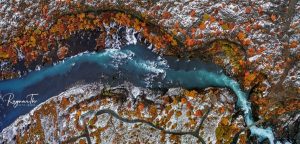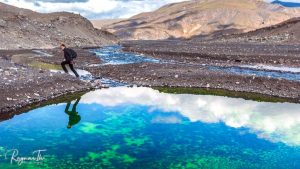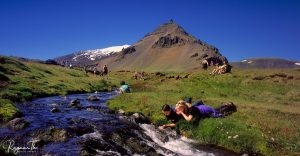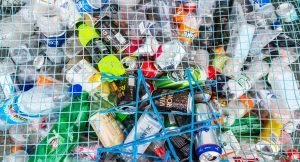Ask anyone living in Iceland – they almost certainly do not buy their water bottled. They drink it straight from the tap, unfiltered. There are many perks to this; the convenience, saving money and protecting the environment among them. It is only normal, though, to have doubts about the quality or safety of tap water. Here, we address those doubts with facts and science.
Before we dive in – we encourage you to take the Kranavatn Challenge, here, and spread the word!
Where does Icelandic tap water come from?
About 95% of the tap water in Iceland is groundwater, which comes from 10-140 meter deep wells. At a certain depth in the Earth, water fills every hole and fracture in the strata. Before reaching that point, it flows through many layers of unsaturated strata that sift impurities from the water. Groundwater is, therefore, generally very clear. Nowhere in the Nordic countries, except in Denmark, is groundwater such a large proportion of tap water.
In a few places in Iceland, the tap water is surface water. This water most often comes from rivers or streams. Before surface water is distributed, it is always purified using ultraviolet rays. This is done mainly to stay safe from microbiological contamination.
In the Reykjavík area and other parts of south-western Iceland, Veitur Utilities handle the supply of tap water (and more services). It is the biggest utility company in the country. They gather drinking water (groundwater) e.g. in Heiðmörk, Berjadalur at Akrafjall and Fossamelar.

Safe from all the bad stuff
Water is classified as food. Icelandic utility companies supplying water are under strict surveillance which municipalities are responsible for. Areas where groundwater is collected are protected according to Icelandic legislation and they are subject to strict pollution prevention. Water quality surveillance is carried out regularly all around the country.
- Microorganisms. Scientists put the most emphasis on microbiological tests.
- Chemical composition. Chemical analysis of Icelandic tap water is also carried out regularly and has increased in recent years. It has e.g. shown that our water contains a minimal amount of chlorine, calcium, and nitrate, which is good news.
- Persistent organic pollutants. Scientists have always found that the amount of those compounds is far below cut off values, both in freshwater biota and in groundwater.
- Heavy metals and dissolved minerals. Just like the persistent organic pollutants, those have always tested below cut off values. No industry in Iceland is known to release a substantial amount of heavy metals into freshwater.
- Pollution from fertilizers. This kind of pollution, mostly due to nitrate, has not been a problem in Iceland. The reason is both that rainfall here is heavy and that only 1.4% of Iceland‘s total area is occupied by arable land.
In recent years, most tests done on Icelandic tap water have turned out great. The only deviations Icelanders have seen from that have been in private supply systems where there were problems with the piping system, or in unfiltered surface water.

What about the smell?
Cold tap water in Iceland generally has no specific smell or taste. Icelandic tap water is not chemically purified with chlorine as it is in many other countries.
Most of the hot tap water, however, has a distinctive smell. It is often likened to rotten eggs, though it is unclear why everyone seems to know the smell of rotten eggs. Most of the warm tap water in Iceland is geothermal water, which contains sulfur. It is the sulfur that causes the unpleasant smell.
A quick heads-up:
- For coffee, tea, noodles, soup, etc. it is best to warm up cold tap water rather than using hot water from a tap.
- When showering or going to a swimming pool, it is best to remove all silver jewelry so that it does not tarnish due to the sulfur.
What about streams in Iceland?
You may have seen some of the beautiful photos travelers in Iceland like to share of themselves – drinking water straight from glittering streams or from impressive rivers. In most cases, this is not harmful at all. But considering how pure it looks, it is interesting to know that tap water may very well be safer to drink. Groundwater, or even purified surface water, is less likely to contain harmful particles or other impurities than the unfiltered surface water in Icelandic rivers and streams.

Why does this information matter?
It is safe to say that plastic pollution is a major environmental problem which affects all life, both on land and in oceans. Many plastic goods are used only once, but they last forever since plastic does not biodegrade in nature and only a small percentage of it is recycled. Plastic contaminates the food chain, affecting the health of all living beings (including human!). Plastic also damages wildlife directly through entanglement and ingestion. Abandoned fishing nets, plastic bottles, and bags are some of the main contributors to this problem. For this reason, drinking tap water from a reusable bottle helps our Planet greatly.

Still thirsty for more?
Here are some fun links if you long for more knowledge about Icelandic water.
- Facts and tips about cold water from Veitur Utilities, the biggest utility company in Iceland.
- An article by The Telegraph, about how Icelanders have urged travelers to drink tap water instead of bottled water.
- If you are feeling extra sciencey, here is a post-print by students from the University of Iceland.
Photographer: Ragnar Th. Sigurðsson

